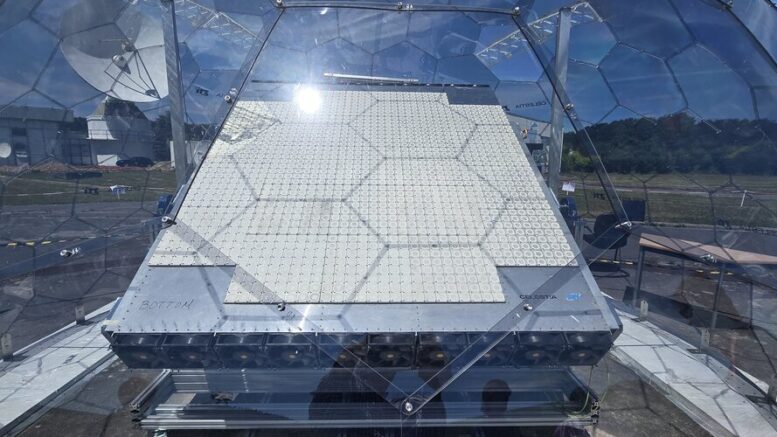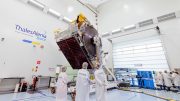Galileo relies on ground-based uplink stations (ULS) to maintain accurate positioning for users worldwide. These stations transmit essential data to the satellites, including the information required to compute the satellites’ orbits and clock corrections. Traditionally, such messages are sent using dish antennas. However, a new type of ground uplink antenna – a phased array antenna – was recently tested at the European Space Agency’s (ESA) site in Redu, Belgium. Developed under ESA’s Horizon 2020 programme for R&D, which aims to keep Galileo up to date with the latest innovations, this innovative antenna could benefit Galileo operations.
While traditional ground stations, using dish antennas, rely on mechanical steering to track and maintain contact with a single satellite, phased array antennas use electronics to steer the radio waves and communicate with satellites. This enables faster satellite pointing and re-pointing, improved reliability over the station’s lifetime and simultaneous communication with multiple satellites.
The ability of one phased array antenna to contact multiple satellites at once could be useful for satellite constellations, such as Galileo Second Generation (G2), which is currently under development. Phased array antennas for uplink could be a more efficient system capable of transmitting more data to more satellites. This could support new and improved services and reduce the number of ground stations and amount of maintenance needed.
As a part of its R&D Programme for Galileo and EGNOS Evolutions, Horizon 2020 (the predecessor of Horizon Europe) has enabled the development of novel technologies which will now be used in G2 space and ground segments. In one of these projects, the ESA Navigation Directorate explores the advantages of using phased array antennas for future ULS of Galileo.
Phased array antennas are already used on satellites, but in 2021, a contract for the development of an ULS Advanced Station was awarded to TTI Norte, with Celestia Antwerp and GMV as subcontractors. This activity aimed to develop and test a phased array antenna prototype compliant with Galileo requirements. Industry teams have now reached the last phase of the demonstration, which involved over-the-air testing and verified the promises of this new technology.
Down to Earth

The development of the new uplink antenna involved two main components: the phased array antenna to uplink signals to the satellite and its modem, to receive information and transform it into a signal the antenna can transmit.
For TTI Norte, the main contractor on this project, developing the phased array antenna meant building nearly everything from scratch. “After the initial design phase, it was decided to develop and manufacture the antenna from basic components, making it a fully European product,” explains Carlos Garcia, ESA Navigation Engineer and Technical Officer for the project. “Each panel of the phased array antenna is made of nearly 1500 individual basic transmission elements, which TTI Norte put together to create the full antenna.”
The full antenna consists of several panels arranged in a truncated pyramid shape. Depending on the design, each panel could communicate with more than one satellite simultaneously.
Long-distance testing
On 4 July 2025, a single panel of the newly developed phased array antennas was put through a demonstration at ESA’s European Space Security and Education Centre (ESEC) in Redu, Belgium. The test aimed to establish a reliable connection with a Galileo satellite dedicated to testing and demonstrate the feasibility of using this technology for data uplink.

For the test, the modem developed by Celestia Antwerp during this project generated the signal. This signal was then amplified and steered by the panel of the phased array antenna. To verify that the signal successfully reached the Galileo satellite, the Galileo Test User Receiver and telemetry data from the satellites that are available at ESA’s European Space Research and Technology Centre (ESTEC) in Noordwijk, the Netherlands were used. Additionally, the tests were coordinated with the Galileo Service Operator to avoid any impact on Galileo services.
“This test was a cooperation among several ESA sites,” notes Karen Ravel, ESA activity coordinator for the Galileo and EGNOS Evolutions Programme. “Many engineers collaborated across sites to verify that the transmitted signal was acquired and tracked by the satellite during the entire pass.”
The test showed that the phased array antenna can transmit signals that reach a satellite in medium Earth orbit more than 23 000 km above Earth. “The full antenna will be more complex and able to contact as many satellites as there are panels on the full antenna,” Karen Ravel says. “But the recent tests in Redu were a key performance demonstration for this technology that confirm the performances achieved on a single link.”
Planning for the future

“In modern constellations such as Galileo, additional services may be needed,” explains David Gomez-Casco, ESA Radio Navigation Engineer and Technical Officer for the project. “If more data needs to be transmitted from the ground to the satellites, more frequent contacts with the satellites will be necessary. To do this, we could either build new parabolic dish antennas, or we could use one or a few phased array antennas composed of multiple panels to reduce the footprint of the station as one antenna can contact several satellites at once.”
Currently the Galileo Programme is exploring different technologies for the future Ground Segment infrastructure evolution, one of them being phased array antennas.
Galileo Second Generation satellites will integrate seamlessly with the current fleet to form the largest European satellite constellation and deliver essential services worldwide. With fully digital navigation payloads, electric propulsion, a better-performing navigation antenna, inter-satellite link capacity and an advanced atomic clock configuration, G2 satellites will provide more robust and reliable positioning, navigation and timing.
About Galileo
Galileo is currently the world’s most precise satellite navigation system, serving over four billion smartphone users around the globe since entering Open Service in 2017. All smartphones sold in the European Single Market are now guaranteed Galileo-enabled. In addition, Galileo is making a difference across the fields of rail, maritime, agriculture, financial timing services and rescue operations.
A flagship programme of the EU, Galileo is managed and funded by the European Commission. Since its inception, ESA, as system development prime and design authority, leads the design, development and qualification of the space and ground systems, and procures launch services. ESA is also entrusted with research and development activities for the future of Galileo within the EU programme Horizon Europe. The EU Agency for the Space Programme (EUSPA) acts as the system prime for the operational system provider, ensuring exploitation and safe and secure delivery of services while overseeing market demands and application needs.
For more info about Galileo: https://www.usegalileo.eu/EN/
About Horizon Europe and Horizon 2020
Horizon Europe is the EU’s key funding programme for the evolution of EGNOS and Galileo, to ensure continuity of service, increased accuracy of positioning and stronger robustness against threats.
ESA has been entrusted with bringing innovative technologies for EGNOS and Galileo to maturity, reducing risks and securing operational systems for the future. Research and innovation happen in close coordination with national space agencies, as well as industry and research institutions.
Horizon Europe builds on Horizon 2020, a funding programme that enabled the development of novel technologies which will now be used in Galileo Second Generation space and ground segments.
Galileo and EGNOS are flagship programmes of the European Union, managed and funded by the European Commission. Since their inception, ESA leads the design, development and qualification of the space and ground systems, as well as procuring launches. The EU Agency for the Space Programme (EUSPA) acts as the service provider, overseeing the market and application needs and closing the loop with users.
Source: ESA










Be the first to comment on "Galileo R&D tests new uplink antenna"